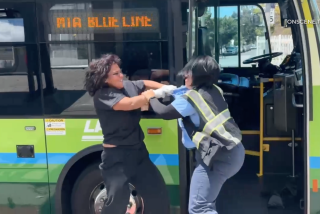Driving the Bus--Almost
- Share via
Daniel Yee and his fellow student bus drivers were barely 10 minutes into their first route Wednesday and already they had flattened two pedestrians, sideswiped a speeding bicyclist and laid down a watery skid mark that stretched the length of six football fields.
It was, as Yee said, an “exhilarating” ride.
But fortunately for those on county streets, this trail of carnage was confined to an Orange County Transit Authority driving simulator--a device intended to teach would-be bus drivers the finer points of handling a 19-ton, 40-foot behemoth.
Instead of leaving a wake of victims and increased insurance premiums, students find their mistakes are simply and cleanly tabulated on a computer and discussed in class.
OCTA began using the machines last year and plans to greatly expand their use in coming months. This week, the transit agency purchased two more simulators for $93,000 and now owns five machines.
“They make the students more cautious, and that’s good,” said Lesley Attanese, manager of driver training. “It’s scary to get in a bus with someone who’s only driven a Volkswagen before. There are some people who just can’t grasp what it means to drive something that’s as big as a bus.”
The simulators use computer discs, projection screens and miniature video cameras to expose student drivers to the white-knuckle moments of an average bus route.
Most of the simulators consist of mock bus cabs and a large viewing screen that flashes images of pedestrians, weaving motorists, speeding firetrucks and other obstacles. As the images flash before the eyes of the student drivers, they respond by twirling their steering wheels and pumping their breaks. A computer records and rates their actions.
For those students who itch for a chance to pilot a real bus, simulators provide some form of satisfaction.
During a simulator class this week, Ana Scherer hoisted her diminutive frame into the seat of one machine, strapped on her seat belt, gripped the steering wheel and worked the brake pedal with lightening reflexes. The 45-year-old Anaheim resident, who abandoned her deli job for the life of a $10-an-hour starting bus driver, said the simulator whetted her appetite for the real thing.
“It was exciting, the steering wheel was so big,” Scherer said. “It makes me really want to drive a bus. I want to drive something big, something with a lot of power.”
Simulators help cure new drivers of their urge to corner too quickly on right hand turns, officials say. Turning too soon can tear mirrors off the side of a bus, send its rear wheels grinding across sidewalks, or crease its side on a power pole.
Officials hope the simulators will ultimately save them cash on fuel, collision repairs and instruction time. They have yet to compile any figures on possible savings.
While the military, firefighters and police have long used simulators for training, simulators are a relatively new arrival to the world of mass transit, said Dave Lindsey, vice president of Doron Precision Systems Inc., the manufacturer. Lindsey said simulators’ popularity has grown in the last three years and identical simulators are now used by transit agencies in Cleveland; Philadelphia; Broward County, Fla.; New Jersey; Delaware and Norfolk, Va.
One OCTA simulator is so large that it occupies two rooms. The machine consists of a scale-model diorama and a motorized toy bus that is controlled by a remote steering console in a separate room. As the student steers the bus through a surreal Mr. Rogers-like neighborhood populated by dolls, tiny traffic cones and toy vehicles, video cameras in the remote control bus beam the images back to the driving console.
This simulator is reserved for special occasions.
“Sometimes, we’ll have a student who’s really all over the place and kind of squirrelly,” Attanese said. “If we think they might damage a bus the first time out, we’ll bring them in here.”
While this larger simulator allows students to practice parallel parking, backing up and their approach to bus stops without using gas or smashing into real estate, it does have one big drawback. Most students can use it for only 10 minutes before they begin to grow dizzy or nauseous.
Officials suspect this is because the combination of video images and surreal landscaping induces a type of motion sickness, but can’t say for sure. (A reporter who used the simulator to negotiate several rows of traffic cones felt his head spinning within minutes and guided the remote-controlled bus into the wall of a miniature apartment building.)
Of course, what the bus simulators don’t simulate is the noise and chatter of a crowded bus during rush hour, or the deadline pressures of meeting a schedule.
Attanese said that when it comes to noise, those who are cut out for the job learn to live with it; those who can’t, quit. As for reinforcing the importance of making scheduled deadlines, Attanese said this was taken care of elsewhere in the drivers’ six-week training course. Students who show up late to class more than once are kicked out.
Ultimately, at the close of their simulator class, students like Yee said they were under no illusions that they could drive a bus from just practicing on a simulator.
“The simulators are fun and exciting,” Yee said. “But there’s a big difference between a training aid and actually driving a bus.”
More to Read
Sign up for Essential California
The most important California stories and recommendations in your inbox every morning.
You may occasionally receive promotional content from the Los Angeles Times.














